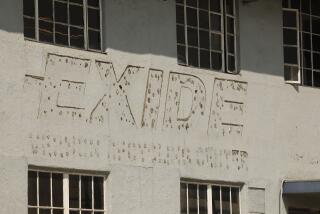Op-Ed: Area 51 holds secrets, all right, but they don’t involve UFOs and aliens
- Share via
For UFO believers and conspiracy theorists, discovering the secrets of Area 51, a tightly guarded military installment in the Nevada desert, has always seemed like the ultimate — if nearly impossible — quest. For decades, there have been rumors of a massive federal coverup to disguise the fact that captured aliens and their spacecraft are being held at the facility.
Recently, the campaign to unlock Area 51’s mysteries has gotten a huge boost from a Facebook campaign, launched as a joke, that is soliciting participants to storm the facility on Sept. 20. Nearly 2 million people have said they will turn out.
While the gate-stormers are unlikely to come back with alien souvenirs, they are right that the government is trying to hide something. There are secrets at Area 51 that should be dragged into public view, and the public has every reason to distrust the government’s statements about the site.
In the late 1990s, I represented workers at Area 51 who were suffering from health issues and trying to find out what toxic substances they had been exposed to on the base. The case ultimately led to the government acknowledging the existence of the site, where highly classified research into next-generation aircraft systems was conducted.
The military has long benefited from the rumors about UFOs at Area 51. If people were busy imagining jars of alien body parts and intergalactic portals, they were not thinking about the real reason the military kept the base shrouded in secrecy long after foreign powers had discovered its existence through satellite photographs.
The workers I represented were suffering from serious illnesses they believed were caused by repeated exposure to the burning of highly toxic materials at Area 51, and the government certainly didn’t want questions asked about that. Two of the workers — Robert Frost and Wally Kasza — have since died. The likely cause of their deaths was as outrageous as it was unnecessary.
For years, Area 51 was a “black facility,” meaning the government wouldn’t acknowledge its existence. Such a designation can be a real benefit for officials who want to ignore environmental and worker safety laws. At Area 51, employees have said, Air Force officials regularly ordered toxic material to be burned in open trenches the length of football fields. Rather than arranging for proper disposal, they simply doused mountains of toxic debris with jet fuel and set it alight, the employees said. Many of those working outside, like Frost and Kasza, developed classic symptoms of toxic exposure. But at Area 51, Air Force officials were able to hide any wrongdoing behind a veil of national security.
That looked like it might change when Frost died. A beloved supervisor, he suffered before his death from a skin condition that is often a symptom of exposure to toxic substances. After he died, others on the base contacted me, and that began the long litigation over Area 51.
I had to meet secretly with my clients in seedy motels and other locations to avoid troubles for them. Testing of the tissues from workers showed chemicals that were unknown to doctors.
We did not sue for damages, just information. Our first challenge was to force acknowledgment that the base even existed. We next had to establish that the government was violating environmental laws. The workers could then, we hoped, learn about the chemicals that were in their systems.
The litigation accomplished something that had previously been unheard of, establishing not only that a black facility existed, but that it was in violation of environmental laws requiring disclosure of information about the handling of certain toxic substances. We hoped this would lead to discovering what the workers were exposed to, but there we hit a wall. Then-President Clinton stepped in and issued a waiver exempting Area 51 from such disclosures.
What was even more painful for the families was that the same week that Clinton signed that despicable order, he also held a national press conference apologizing for the actions of his predecessors in exposing workers in the same general area to nuclear testing and then covering up the harm to workers and military personnel. Even as he enjoyed praise for his empathy, Clinton barred Area 51 workers from obtaining the same information.
The denial of the existence of Area 51 was always absurd. We were able to take pictures of the base from a nearby mountain. And when we secured foreign satellite imagery of the base and threatened to call on the military attaché to the Russian embassy to tell the American people about the base, the government finally relented and confirmed its existence, calling it “the operating location near Groom Lake.”
Area 51 is an example of a culture of government secrecy that continues to erode any trust in information by the public. In the absence of actual information, rumors and conspiracy theories have flourished. The base has become a bit of American social kitsch, the subject of curiosity and jokes. Anheuser-Busch recently declared, for example, that it would provide “free Bud Light to any alien that makes it out” of the facility.
If history is any judge, it might be easier for an alien to make it out of Area 51 than the truth.
Jonathan Turley, a professor of public interest law at George Washington University, represented workers at Area 51 during the 1990s.
More to Read
A cure for the common opinion
Get thought-provoking perspectives with our weekly newsletter.
You may occasionally receive promotional content from the Los Angeles Times.










